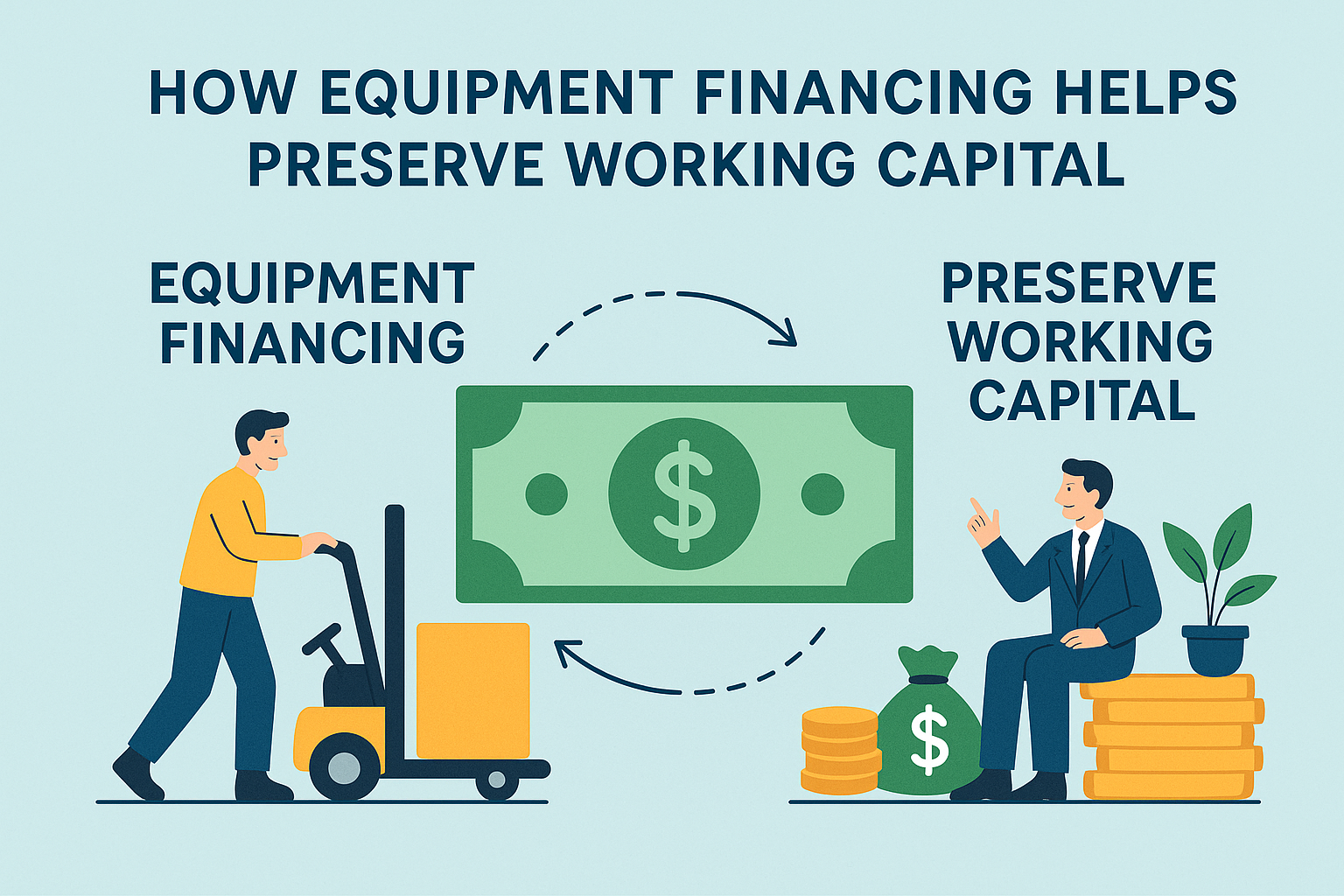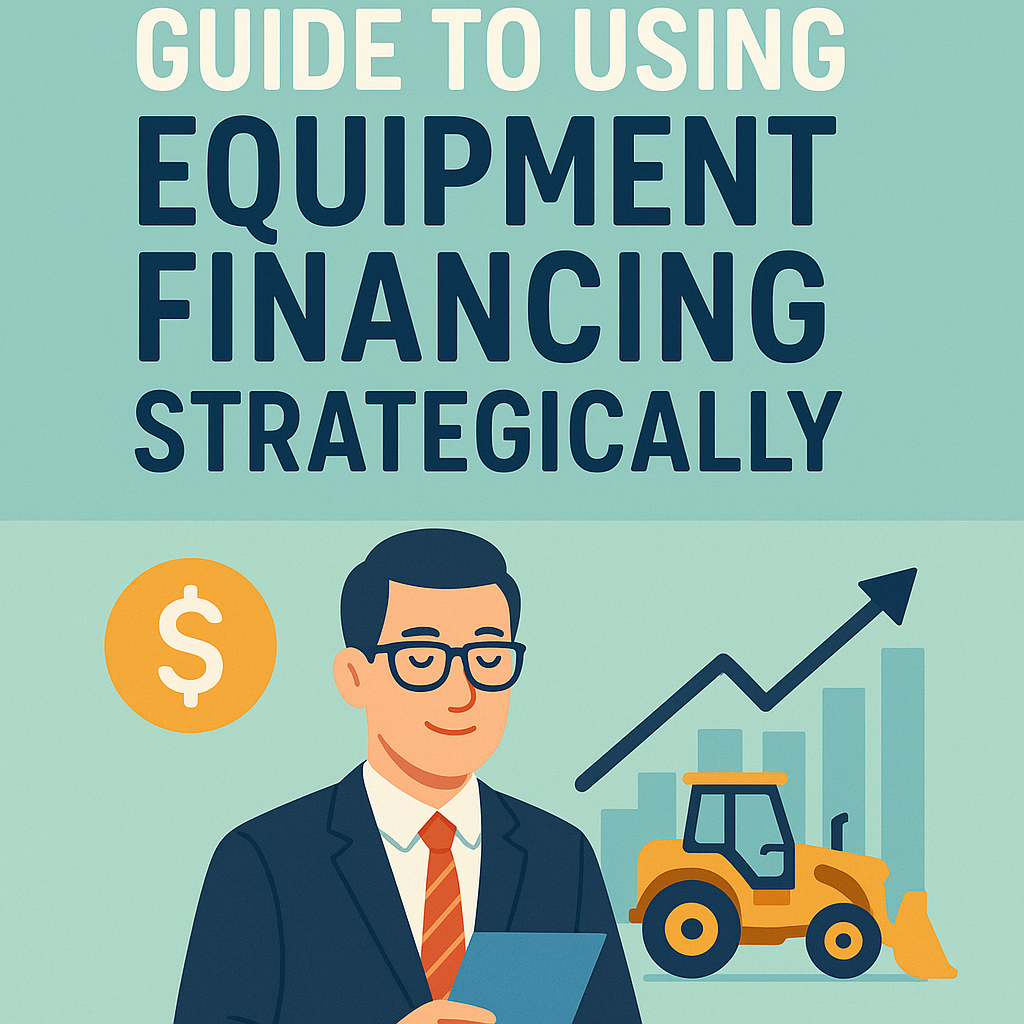How Equipment Financing Helps Preserve Working Capital
Equipment Financing Preserves Working Capital
Working capital represents the lifeblood of any business operation. When companies need new equipment but want to maintain cash flow flexibility, equipment financing emerges as a powerful solution. This financing strategy allows businesses to acquire essential machinery, technology, and tools while keeping their working capital intact for daily operations. By avoiding large upfront costs, businesses can retain liquidity to handle payroll, inventory, marketing, and other operational needs. This approach not only minimizes financial strain but also enhances the company’s ability to adapt to growth opportunities or unexpected challenges.
Understanding Working Capital and Its Importance
Working capital measures a company’s short-term financial health by calculating the difference between current assets and current liabilities. This metric determines how effectively a business can meet its immediate operational needs, from paying suppliers to covering payroll expenses.
Businesses with healthy working capital levels can navigate unexpected challenges, take advantage of growth opportunities, and maintain smooth operations without financial strain. When working capital becomes tied up in equipment purchases, companies often struggle with cash flow management and operational flexibility.
This challenge is particularly acute for startups, making equipment financing solutions a critical consideration for new businesses seeking to preserve their cash reserves.
The Equipment Financing Solution
Equipment financing provides businesses with the means to acquire necessary equipment without depleting their cash reserves. This financing method uses the purchased equipment as collateral, making it a secured loan option that typically offers favorable terms and interest rates.
Understanding how to use equipment financing effectively begins with recognizing that this approach differs significantly from traditional business loans. Unlike conventional loans that require substantial cash down payments, equipment financing often covers the full purchase price of equipment.
This approach allows companies to preserve their working capital while still obtaining the tools they need to operate efficiently and competitively.
Key Benefits of Equipment Financing for Working Capital Preservation
The benefits of equipment financing extend far beyond simple asset acquisition, creating a comprehensive strategy for financial management and business growth.
Immediate Cash Flow Relief
Equipment financing eliminates the need for large upfront payments that would otherwise drain working capital reserves. Instead of paying hundreds of thousands of dollars immediately, businesses can spread equipment costs over manageable monthly payments that align with their cash flow patterns.
Operational Continuity
Maintaining working capital ensures businesses can continue meeting their day-to-day obligations without interruption. Companies can pay vendors on time, maintain inventory levels, and handle unexpected expenses while their new equipment generates revenue to cover financing payments.
Growth Opportunity Management
Equipment financing preserves working capital by eliminating the need for large upfront payments. Instead of spending hundreds of thousands at once, businesses can spread costs over manageable monthly payments that align with cash flow. This approach keeps working capital intact for daily operations and creates a financial buffer. Preserved cash allows businesses to seize growth opportunities, expand into new markets, or manage seasonal inventory—maintaining flexibility without compromising financial stability.
For emerging companies, this preserved capital serves as a secret weapon for startups, enabling them to compete with established businesses while maintaining financial stability.
Risk Mitigation
Equipment financing preserves working capital, enabling businesses to maintain financial reserves amid economic uncertainties and market fluctuations. By avoiding large upfront equipment costs, companies can keep cash available for essential operations, ensuring stability and resilience during challenging times.
Types of Equipment Financing Options
Equipment Loans
Traditional equipment loans provide funds specifically for equipment purchases, with the equipment serving as collateral. These loans typically offer competitive interest rates and terms ranging from two to seven years, depending on the equipment’s expected useful life.
Equipment Leasing
Leasing arrangements allow businesses to use equipment without ownership responsibilities. Operating leases preserve working capital while providing access to equipment, though companies don’t build equity in the assets.
Lines of Credit for Equipment
Equipment lines of credit offer flexible access to funds for equipment purchases. Businesses can draw funds as needed and only pay interest on the amount used, providing maximum working capital preservation flexibility.
Vendor Financing Programs
Many equipment manufacturers and dealers offer financing programs directly to customers. These programs often feature competitive terms and streamlined approval processes, making equipment acquisition more accessible while preserving cash.
Strategic Implementation of Equipment Financing
Timing Considerations
Successful equipment financing requires careful timing alignment with business cash flow cycles. Companies should evaluate their seasonal patterns, upcoming contracts, and projected revenue streams to determine optimal financing timing.
Equipment Selection Strategy
Equipment financing preserves working capital when businesses strategically select assets that align with both current needs and future growth. By prioritizing equipment that delivers immediate revenue or operational efficiency, companies can justify financing costs while maintaining liquidity for other critical investments.
Financial Planning Integration
Equipment financing decisions should integrate with broader financial planning strategies. Companies need to ensure that financing payments align with their working capital management goals and overall business objectives.
Industry-Specific Applications
Manufacturing Sector
Manufacturing companies often require expensive machinery and production equipment. Equipment financing allows manufacturers to upgrade their capabilities without compromising their ability to purchase raw materials or manage inventory fluctuations.
Construction Industry
Construction businesses need heavy equipment, vehicles, and specialized tools. Financing these assets preserves working capital for project materials, labor costs, and the cash flow gaps common in construction project cycles.
Healthcare Organizations
Medical facilities require sophisticated equipment that can cost millions of dollars. Equipment financing enables healthcare providers to acquire advanced technology while maintaining working capital for staffing, supplies, and facility operations.
Technology Companies
Technology businesses need servers, software, and specialized equipment that becomes obsolete quickly. Equipment financing allows tech companies to stay current with technology trends while preserving cash for research, development, and market expansion.
Financial Impact Analysis
Cash Flow Enhancement
Equipment financing transforms large capital expenditures into predictable monthly payments. This payment structure improves cash flow forecasting and helps businesses maintain consistent working capital levels throughout the financing period.
Tax Advantages
One of the equipment financing secrets that many businesses overlook involves the significant tax benefits of equipment financing. These arrangements often provide substantial tax advantages through depreciation deductions and interest expense write-offs.
Section 179 deductions allow businesses to deduct the full purchase price of qualifying equipment in the year of purchase, while bonus depreciation can provide additional tax benefits. These advantages can improve overall financial performance while the preserved working capital generates additional business value.
Return on Investment Optimization
By preserving working capital through equipment financing, businesses can potentially achieve higher returns on their cash reserves. The preserved capital can be invested in marketing, inventory, or other revenue-generating activities that may yield returns exceeding the financing costs.
Best Practices for Equipment Financing Success
Due Diligence Requirements
Thorough equipment evaluation ensures financing decisions align with business needs and working capital preservation goals. Companies should assess equipment quality, expected useful life, maintenance requirements, and potential resale value.
Lender Relationship Management
Building strong relationships with equipment financing lenders can provide better terms and more flexible arrangements. Long-term lender relationships often result in improved financing options and faster approval processes.
Documentation and Compliance
Proper documentation and compliance with financing agreements protect both the business and lender interests. Clear understanding of terms, conditions, and obligations helps avoid complications that could impact working capital management.
Common Challenges and Solutions
Qualification Requirements
Equipment financing requires meeting specific credit and financial criteria. Businesses can improve their qualification chances by maintaining good credit histories, providing comprehensive financial documentation, and demonstrating stable cash flows.
Interest Rate Management
Equipment financing interest rates vary based on creditworthiness, equipment type, and market conditions. Companies can secure better rates by shopping multiple lenders, improving their credit profiles, and timing their applications strategically.
Equipment Obsolescence Risk
Rapid technological changes can make financed equipment obsolete before loans are paid off. Businesses can mitigate this risk by choosing equipment with longer useful lives or selecting financing terms that align with technology refresh cycles.
Future Trends in Equipment Financing
Current Equipment Financing Market Trends indicate a rapidly evolving landscape that’s transforming equipment financing as we know it.
Technology Integration
Digital platforms are streamlining equipment financing applications and approvals. Online tools provide faster processing, better rate comparisons, and improved working capital preservation planning capabilities.
Artificial intelligence and machine learning algorithms are revolutionizing underwriting processes, making Equipment Financing Solutions more accessible to businesses of all sizes.
Flexible Financing Structures
Lenders increasingly offer customized financing structures that align with specific business cash flow patterns. These flexible arrangements better support working capital preservation while meeting equipment acquisition needs.
Seasonal payment plans, revenue-based repayment options, and hybrid lease-purchase agreements represent innovative startup financing solutions that cater to diverse business models.
Sustainability Focus
Equipment financing preserves working capital while also supporting sustainability goals, especially as environmental considerations shape financing decisions. Many lenders now offer favorable terms for energy-efficient equipment, helping businesses reduce upfront costs and maintain liquidity. Green financing initiatives further incentivize investments in environmentally responsible assets, aligning financial strategy with long-term environmental impact.
Frequently Asked Questions
What is equipment financing and how does it work?
Equipment financing is a business loan specifically designed for purchasing equipment, machinery, or vehicles. The equipment itself serves as collateral for the loan. Businesses receive funds to purchase equipment and repay the loan through fixed monthly payments over a predetermined period, typically 2-7 years. This arrangement allows companies to acquire necessary equipment without using their cash reserves.
How much working capital can equipment financing help preserve?
Equipment financing can preserve 80-100% of the working capital that would otherwise be spent on equipment purchases. For example, if a company needs $500,000 in equipment, financing can preserve nearly all of that cash for operational needs, with only small down payments or fees required upfront. The exact amount depends on the financing terms and lender requirements.
What types of equipment qualify for financing?
Most business equipment qualifies for financing, including manufacturing machinery, construction equipment, medical devices, office technology, vehicles, restaurant equipment, and agricultural machinery. The equipment must be used for business purposes and typically needs to have a useful life that extends beyond the financing term. Some lenders specialize in specific equipment types.
What are the typical interest rates for equipment financing?
Equipment financing interest rates typically range from 6% to 30%, depending on factors such as creditworthiness, equipment type, loan amount, and term length. Businesses with strong credit profiles can often secure rates in the lower range, while newer businesses or those with credit challenges may face higher rates. Shopping multiple lenders helps secure competitive rates.
How long does the equipment financing approval process take?
The approval process for equipment financing typically takes 1-5 business days for straightforward applications. Simple financing requests with strong credit can receive approval within 24 hours, while more complex applications may require additional documentation and take up to two weeks. Online lenders often provide faster processing than traditional banks.
Can startups and new businesses qualify for equipment financing?
Yes, startups and new businesses can qualify for equipment financing, though they may face stricter requirements. Lenders typically require personal guarantees from business owners, higher down payments, or additional collateral. New businesses should demonstrate strong business plans, industry experience, and adequate cash flow projections to improve their approval chances.
What happens if a business cannot make equipment financing payments?
If a business defaults on equipment financing payments, the lender can repossess the equipment that serves as collateral. However, most lenders prefer to work with borrowers to modify payment terms or restructure loans before resorting to repossession. Early communication with lenders about payment difficulties often leads to workable solutions.
Is equipment leasing better than equipment financing for preserving working capital?
Equipment leasing and financing both preserve working capital but in different ways. Leasing typically requires lower upfront costs and may offer better short-term cash flow benefits. However, financing builds equity in the equipment and may provide better long-term value. The best choice depends on specific business needs, tax situations, and long-term equipment plans.
How does equipment financing affect business credit scores?
Equipment financing can positively impact business credit scores when payments are made on time. The loan appears as a business debt obligation, and consistent payments demonstrate creditworthiness to future lenders. However, missed payments or defaults can negatively affect credit scores, making future financing more difficult or expensive.
Can businesses refinance existing equipment loans?
Yes, businesses can often refinance existing equipment loans to take advantage of better interest rates, extend payment terms, or free up additional working capital. Refinancing makes sense when current market rates are significantly lower than existing loan rates or when businesses need to improve their cash flow through longer payment terms.
What documentation is required for equipment financing applications?
Equipment financing preserves working capital by allowing businesses to acquire assets without large upfront costs—but it also requires proper documentation to secure approval. Typical requirements include business financial statements, tax returns, bank statements, equipment quotes or invoices, business licenses, and personal financial details for guarantors. Depending on the loan amount and complexity, some lenders may also request business plans, industry references, or equipment appraisals. With the right paperwork in place, businesses can access financing efficiently while maintaining the liquidity needed for growth and operations.
How does equipment financing compare to using business credit cards for equipment purchases?
Equipment financing typically offers lower interest rates and longer repayment terms than business credit cards, making it more cost-effective for larger equipment purchases. Credit cards provide more flexibility but usually have higher interest rates and shorter payment periods. Equipment financing is generally better for preserving working capital on significant equipment investments.
Conclusion
Equipment financing serves as a strategic tool for businesses seeking to acquire necessary equipment while preserving their working capital. This financing approach enables companies to maintain operational flexibility, pursue growth opportunities, and manage financial risks more effectively.
Equipment financing preserves working capital by aligning with broader business goals and financial strategies. When used effectively, it supports sustainable growth while maintaining cash flow flexibility. This preserved capital helps businesses face challenges, pursue new opportunities, and build a stronger financial future.





No comment